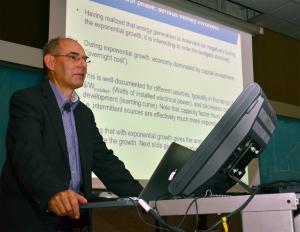In terms of development, is fusion really different?
17 Sep 2012
-
Robert Arnoux
Contrary to widespread opinion, investment in fusion is quite low when compared to that of other emerging energy sources. According to Prof. Lopes-Cardozo "the spending on fusion will have to double every five years or so" if we want to bring fusion power to the grid before 2060.
There's good and there's bad in the public perception of what fusion is about. On the bright side, it is a "clean, safe, for all and forever" potential source of energy; on the not-so-bright one, it is "expensive and takes forever." Fusion energy, as the worn-out joke goes, will always be 50 years away.
But is fusion development really different from that of other energy sources? In other words, how does fusion fit into "the spectrum of energy technology developments"?
Niek Lopes-Cardozo, a veteran fusion physicist and a professor at Eindhoven (NL) University of Technology was at ITER this Thursday 13 September to provide answers to this question.
The many graphs and figures he presented to the Inside-ITER audience demonstrate that all energy sources—fission, solar, wind, etc.,—are governed by the same development model.
They all go through a phase of "exponential growth to materiality" during which no net energy is produced. This first phase can last 30 to 50 years during which the emerging energy source is a "niche market," helped along by public subsidies.
Whether the emerging source generates 10 MW or 100 GW of energy during that period doesn't make much of a difference: it is still a fraction of the global needs, it "doesn't save the world," and it doesn't pay back the energy invested to bring it to 'materiality'".
The second phase of any energy source development is characterized by a 30- to 50-year "linear growth" and this is when the new energy source becomes competitive.
Now where does fusion fit into that picture? A crucial factor in the transition from R&D (the present state of fusion) to "exponential growth to materiality" is the size of the capital investment. As demonstrated by Lopes-Cardozo's figures, and contrary to widespread opinion, investment in fusion is quite low when compared to that of other emerging energy sources.
Take wind, for instance: global investment is presently in the range of EUR 100 billion per year; it is EUR 50 billion per year for photovoltaic and EUR 20 billion for concentrated solar power.
Compared to these numbers, fusion, with a mere EUR 2 billion per year is the poor man of energy research. "We should not pretend that we can go exponential with the present budgets allocated to fusion," said Lopes-Cardozo.
Addressing "the heroes" of the "cornerstone project in fusion", he insisted on the importance of "staying on the roadmap" and of continuing to aim at bringing fusion power to the grid before 2060. This implies that "the spending on fusion will have to double every five years or so—as it does for other energy sources in development."


